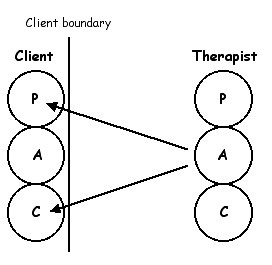A good deal of the usual counselling process involves presenting something to the client that may be new and then waiting for the client to do something with it. In this way it can be seen as a passive process.

This diagram shows how the therapist can present a variety of new or different actions, communications or relationship styles to the client. Once done the therapist then remains inactive to see what the client does with them, if anything. It is hoped that the client will take them and then alter something within their personality thus leading to psychological change. However as far a the therapist is concerned it remains as a hope. The therapist simply has to wait and see.
Two chair techniques allow the therapist to be more active. It allows the therapist to actually directly delve into the personality of the client. To get right into the personality of the client and change things around by stimulating various parts, highlighting them to the client and so forth. It also allows the therapist to establish relational contact directly with various aspects of the client’s personality.

This diagram shows that with the client’s permission the therapist can move beyond the exterior of the client’s personality and delve into the actual personality of the client using therapy processes such as two chair.
An important aspect of two chair is that the person does not take the role of the other party. If a client puts his mother in the other chair and then moves to be in mother’s chair he is not role playing mother. In that chair he is being the projection of his introjected mother. It is part of his personality in the chair not his memory of mother. In psychodrama one can role play other parties. In the two chair being described one is being part of their own personality in the other chair and not playing a role.
Two chairs techniques are also regressive techniques. It encourages the client to regress into their Child ego state from many years ago. This is a good thing as it provides a relatively easy way to get the Child ego state into the therapy room which should happen in most sessions. Generally speaking the focus of therapy is approximately:

Graffiti
This is an interesting post but I’m having trouble with the idea that the person ”is not role playing mother” but “being the projection of his introjected mother”. If you have time, can you explain how these two things are different? Or maybe, how can you tell the difference between role playing mother and projecting an introjected mother?
ReplyDeleteHello KYLady
ReplyDeleteRole playing is what actors do. They study their subject and then teach themselves how to act like they do. When role playing they are thinking about how the person being role played would behave.
All of us as children introject or imitate mother. When we do this we take that model of mother into our Parent ego state. When this is done it becomes part of our own personality. When we display this part in an empty chair one does not need to think how mother may react one simply be’s this part of their own personality and speak. It’s a much easier process than role playing because you don’t have to try and act how you think mother would behave. One simply be’s that part of their own personality and speaks.
graffiti
So, maybe what you mean is that you don’t ask the person to be the mother in the chair, but it’s more like you have them say what they assume their mother would say if she were sitting in the chair. Is that it? If that’s it, it seems like splitting a very fine hair.
ReplyDeleteI don't think it is really hair splitting KYLady,
ReplyDeleteIn the usual two chair I would sit them in the empty chair and say:
"Be your self and talk"
IN role playing I would say:
"Think of your mother and role play her when I ask questions"
Graffiti
So... when you ask me to 'be myself and talk' you will also have or will ask me question/s to answer as myself? Or would you just prompt me into speaking?
ReplyDeleteI think i would need that at the very least.
Yes Roses, it really can't be done by yourself. You can do a bit but for any especially regressive two chair you need a therapist there directing traffic.
ReplyDeleteThe vast majority of people find it quite easy to do roses. For example to sit in mother's chair and be that part of their own Parent ego state most find quite easy to do.
that is why next week I am running an entire workshop on how to do the two chair technique
Graffiti